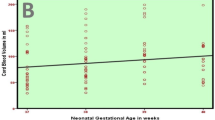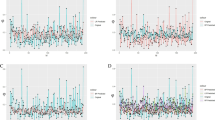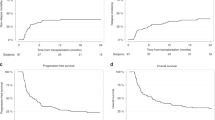Abstract
The public French Cord Blood Banks Network was established in 1999 with the objective of standardizing the practices governing umbilical cord blood (UCB) banking in France. The Network adopted a strategy to optimize its inventory and improve the quality of its banked units based on a quality improvement process using outcome data regularly provided by Eurocord. This study aimed to describe the results, over 10 years, of UCBT facilitated by a national network that used the same criteria of UCB collection and banking and to assess how modifications of banking criteria and unit selection might influence transplant outcomes. Nine hundred and ninety-nine units (593 single-unit and 203 double-unit grafts) were released by the Network to transplant 796 patients with malignant (83%) and non-malignant (17%) diseases. Median cell dose exceeded 3.5 × 107 TNC/kg in 86%. There was a trend to select units more recently collected and with higher cell dose. Neutrophil engraftment was 88.2% (85.7–90.7) and 79.3% (72.6–86.5) respectively for malignant and non-malignant diseases with a trend to faster recovery with higher cell doses. The respective 3-year transplant-related mortality were 31.1% (27.5–35.1) and 34.3% (27.0–43.5). OS was 49% ± 4 in malignant and 62% ± 4 in non-malignant disorders. In multivariate analysis, cell dose was the only unit-related factor associated with outcomes. Our results reflect the benefit on clinical outcomes of the strategy adopted by the Network to bank units with higher cell counts.
This is a preview of subscription content, access via your institution
Access options
Subscribe to this journal
Receive 12 print issues and online access
$259.00 per year
only $21.58 per issue
Buy this article
- Purchase on SpringerLink
- Instant access to full article PDF
Prices may be subject to local taxes which are calculated during checkout



Similar content being viewed by others
References
Gluckman E, Broxmeyer HE, Auerbach AD, Friedman HS, Douglas GW, Devergie A, et al. Hematopoietic reconstitution in a patient with Fanconi’s anemia by means of umbilical-cord blood from an HLA-identical sibling. N. Engl J Med. 1989;321:1174–8.
Gluckman E, Rocha V. Cord blood transplantation: state of the art. Haematologica. 2009;94:451–4.
Gluckman E, Ruggeri A, Volt F, Cunha R, Boudjedir K, Rocha V. Milestones in umbilical cord blood transplantation. Br J Haematol. 2011;154:441–7.
Ballen KK, Gluckman E, Broxmeyer HE. Umbilical cord blood transplantation: the first 25 years and beyond. Blood. 2013;122:491–498.
Barker JN, Kurtzberg J, Ballen K, Boo M, Brunstein C, Cutler C, et al. Optimal practices in unrelated donor cord blood transplantation for hematologic malignancies. Biol Blood Marrow Transpl. 2017;23:882–96.
Rocha V, Wagner JE, Sobocinski KA, Klein JP, Zhang M-J, Horowitz MM, et al. Graft-versus-host disease in children who have received a cord-blood or bone marrow transplant from an hla-identical sibling. N. Engl J Med. 2000;342:1846–54.
Rocha V, Labopin M, Sanz G, Arcese W, Schwerdtfeger R, Bosi A, et al. Transplants of umbilical-cord blood or bone marrow from unrelated donors in adults with acute leukemia. N. Engl J Med. 2004;351:2276–85.
Weisdorf D, Eapen M, Ruggeri A, Zhang M-J, Zhong X, Brunstein C, et al. Alternative donor transplantation for older patients with acute myeloid leukemia in first complete remission: a center for international blood and marrow transplant research-eurocord analysis. Biol Blood Marrow Transpl. 2014;20:816–22.
Ruggeri A, Sanz G, Bittencourt H, Sanz J, Rambaldi A, Volt F, et al. Comparison of outcomes after single or double cord blood transplantation in adults with acute leukemia using different types of myeloablative conditioning regimen, a retrospective study on behalf of Eurocord and the Acute Leukemia Working Party of EBMT. Leukemia. 2014;28:779–86.
Laughlin MJ, Eapen M, Rubinstein P, Wagner JE, Zhang M-J, Champlin RE, et al. Outcomes after transplantation of cord blood or bone marrow from unrelated donors in adults with leukemia. N. Engl J Med. 2004;351:2265–75.
Brunstein CG, Fuchs EJ, Carter SL, Karanes C, Costa LJ, Wu J, et al. Alternative donor transplantation after reduced intensity conditioning: results of parallel phase 2 trials using partially HLA-mismatched related bone marrow or unrelated double umbilical cord blood grafts. Blood. 2011;118:282–8.
Rocha V, Gluckman E, on behalf of the Eurocord-Netcord registry and European Blood and Marrow Transplant group. Improving outcomes of cord blood transplantation: HLA matching, cell dose and other graft- and transplantation-related factors. Br J Haematol. 2009;147:262–74.
Barker JN, Scaradavou A, Stevens CE. Combined effect of total nucleated cell dose and HLA match on transplantation outcome in 1061 cord blood recipients with hematologic malignancies. Blood. 2010;115:1843–9.
Eapen M, Klein JP, Sanz GF, Spellman S, Ruggeri A, Anasetti C, et al. Effect of donor-recipient HLA matching at HLA A, B, C, and DRB1 on outcomes after umbilical-cord blood transplantation for leukaemia and myelodysplastic syndrome: a retrospective analysis. Lancet Oncol. 2011;12:1214–21.
Eapen M, Klein JP, Ruggeri A, Spellman S, Lee SJ, Anasetti C, et al. Impact of allele-level HLA matching on outcomes after myeloablative single unit umbilical cord blood transplantation for hematologic malignancy. Blood. 2014;123:133–40.
Eapen M, Wang T, Veys PA, Boelens JJ, St Martin A, Spellman S, et al. Allele-level HLA matching for umbilical cord blood transplantation for non-malignant diseases in children: a retrospective analysis. Lancet Haematol. 2017;4:e325–33.
Ruggeri A. Optimizing cord blood selection. Hematology. 2019;2019:522–31.
Dehn J, Spellman S, Hurley CK, Shaw BE, Barker JN, Burns LJ, et al. Selection of unrelated donors and cord blood units for hematopoietic cell transplantation: guidelines from the NMDP/CIBMTR. Blood. 2019;134:924–34.
Étude de législation comparée n° 187 - septembre 2008 - La conservation du sang placentaire. https://www.senat.fr/lc/lc187/lc187_mono.html. 2008.
International standards for cord blood collection, banking and release for administration, accreditation manual. http://www.factwebsite.org/uploadedFiles/Standards/NetCord%20FACT%206th%20Ed%20Manual%20Draft.09.01.15.pdf.
Przepiorka D, Weisdorf D, Martin P, Klingemann HG, Beatty P, Hows J, et al. 1994 Consensus Conference on Acute GVHD Grading. Bone Marrow Transplant. 1995;15:825–8.
Martin PJ, Weisdorf D, Przepiorka D, Hirschfeld S, Farrell A, Rizzo JD, et al. National Institutes of Health Consensus Development Project on Criteria for Clinical Trials in Chronic Graft-versus-Host Disease: VI. Design of Clinical Trials Working Group Report. Biol Blood Marrow Transpl. 2006;12:491–505.
Spyridonidis A, Labopin M, Savani BN, Niittyvuopio R, Blaise D, Craddock C, et al. Redefining and measuring transplant conditioning intensity in current era: a study in acute myeloid leukemia patients. Bone Marrow Transplant. 2020; https://doi.org/10.1038/s41409-020-0803-y.
Cox DR. Regression models and life-tables. J R Stat Soc Ser B Methodol. 1972;34:187–220.
Gooley TA, Leisenring W, Crowley J, Storer BE. Estimation of failure probabilities in the presence of competing risks: new representations of old estimators. Stat Med. 1999;18:695–706.
Wagner JE, Broxmeyer HE, Byrd RL, Zehnbauer B, Schmeckpeper B, Shah N, et al. Transplantation of umbilical cord blood after myeloablative therapy: analysis of engraftment. Blood. 1992;79:1874–81.
Wagner JohnE, Steinbuch M, Kernan NancyA, Broxmayer HalE, Gluckman E. Allogeneic sibling umbilical-cord-blood transplantation in children with malignant and non-malignant disease. Lancet. 1995;346:214–9.
Kurtzberg J, Laughlin M, Graham ML, Smith C, Olson JF, Halperin EC, et al. Placental blood as a source of hematopoietic stem cells for transplantation into unrelated recipients. N. Engl J Med. 1996;335:157–66.
Rubinstein P, Carrier C, Scaradavou A, Kurtzberg J, Adamson J, Migliaccio AR, et al. Outcomes among 562 recipients of placental-blood transplants from unrelated donors. N. Engl J Med. 1998;339:1565–77.
Broxmeyer HE, Lee M-R, Hangoc G, Cooper S, Prasain N, Kim Y-J, et al. Hematopoietic stem/progenitor cells, generation of induced pluripotent stem cells, and isolation of endothelial progenitors from 21- to 23.5-year cryopreserved cord blood. Blood. 2011;117:4773–7.
Rubinstein P, Dobrila L, Rosenfield RE, Adamson JW, Migliaccio G, Migliaccio AR, et al. Processing and cryopreservation of placental/umbilical cord blood for unrelated bone marrow reconstitution. Proc Natl Acad Sci USA. 1995;92:10119–22.
Rubinstein P, Taylor PE, Scaradavou A, Adamson JW, Migliaccio G, Emanuel D, et al. Unrelated placental blood for bone marrow reconstitution: organization of the placental blood program. Blood Cells. 1994;20:587–96 ; discussion 596-600.
Navarrete C, Contreras M. Cord blood banking: a historical perspective. Br J Haematol. 2009;147:236–45.
Lazzari L, Corsini C, Curioni C, Lecchi L, Scalamogna M, Rebulla P, et al. The Milan Cord Blood Bank and the Italian Cord Blood Network. J Hematother. 1996;5:117–22.
Navarrete C, Warwick R, Armitage S, Fehily D, Contreras M. The London Cord Blood Bank. Bone Marrow Transpl. 1998;22:S6–7.
Querol S, Gabarró M, Amat L, Gonzalez S, Gomez MD, de la Calle O, et al. The placental blood program of the Barcelona Cord Blood Bank. Bone Marrow Transpl. 1998;22:S3–5.
Dal Cortivo L, Marolleau JP, Gluckman E, Chavinié J, Brossard Y, Benbunan M. The Paris Cord Blood Bank. Bone Marrow Transpl. 1998;22:S11.
Wernet PW. The International Netcord Foundation. In: Broxmeyer He, editor. Cord blood: biology, immunology, banking and clinical transplantation. Bethesda, Md: Aabb Press; 2004. P. 429–35.
WMDA report. Total Number of Donors and Cord blood units. https://statistics.wmda.info/;https://wmda.info/cord-blood/basics-cord-blood/; 2020.
Mayani H, Wagner JE, Broxmeyer HE. Cord blood research, banking, and transplantation: achievements, challenges, and perspectives. Bone Marrow Transplant. 2020;55:48–61.
Magalon J, Gamerre M, Picard C, Chabannon C. Increase the quality of banked cord blood units without limiting HLA diversity: how cord blood banks could face this dilemma. Transfus. 2014;54:495–6.
Stritesky G, Wadsworth K, Duffy M, Buck K, Dehn J. Evaluation of the impact of banking umbilical cord blood units with high cell dose for ethnically diverse patients. Transfus. 2018;58:345–51.
Querol S, Gomez SG, Pagliuca A, Torrabadella M, Madrigal JA. Quality rather than quantity: the cord blood bank dilemma. Bone Marrow Transpl. 2010;45:970–8.
Feve F, Cambon-Thomsen A, Eliaou J-F, Gourraud P-A, Raffoux C, Florens J-P. Economic evaluation of the organization of a registry of haematopoietic stem cell donors. Rev Epidemiol Sante Publique. 2007;55:275–84.
Ruggeri A, Paviglianiti A, Gluckman E, Rocha V. Impact of HLA in cord blood transplantation outcomes. HLA. 2016;87:413–21.
Hough R, Danby R, Russell N, Marks D, Veys P, Shaw B, et al. Recommendations for a standard UK approach to incorporating umbilical cord blood into clinical transplantation practice: an update on cord blood unit selection, donor selection algorithms and conditioning protocols. Br J Haematol. 2016;172:360–70.
Gutman JA, Ross K, Smith C, Myint H, Lee C-K, Salit R, et al. Chronic graft versus host disease burden and late transplant complications are lower following adult double cord blood versus matched unrelated donor peripheral blood transplantation. Bone Marrow Transpl. 2016;51:1588–93.
Lazaryan A, Weisdorf DJ, DeFor T, Brunstein CG, MacMillan ML, Bejanyan N, et al. Risk factors for acute and chronic graft-versus-host disease after allogeneic hematopoietic cell transplantation with umbilical cord blood and matched sibling donors. Biol Blood Marrow Transpl. 2016;22:134–40.
Milano F, Gooley T, Wood B, Woolfrey A, Flowers ME, Doney K, et al. Cord-blood transplantation in patients with minimal residual disease. N. Engl J Med. 2016;375:944–53.
Veys P, Danby R, Vora A, Slatter M, Wynn R, Lawson S, et al. UK experience of unrelated cord blood transplantation in paediatric patients. Br J Haematol. 2016;172:482–6.
Pupella S, Bianchi M, Ceccarelli A, Calteri D, Lombardini L, Giornetti A, et al. A cost analysis of public cord blood banks belonging to the Italian Cord Blood Network. Blood Transfus. Trasfus Sangue. 2018;16:313–20.
Sacchi N. Is it time to re-think a sustainable banking model for the Italian Cord Blood Network? Blood Transfus Trasfus Sangue. 2018;16:221–3.
Querol S, Rubinstein P, Marsh SGE, Goldman J, Madrigal JA. Cord blood banking: ‘providing cord blood banking for a nation. Br J Haematol. 2009;147:227–35.
Magalon J, Maiers M, Kurtzberg J, Navarrete C, Rubinstein P, Brown C, et al. Banking or bankrupting: strategies for sustaining the economic future of public cord blood banks. PLoS ONE. 2015;10:e0143440.
Rubinstein P. Cord blood banking for clinical transplantation. Bone Marrow Transpl. 2009;44:635–42.
Allan D, Kiernan J, Gragert L, Dibdin N, Bartlett D, Campbell T, et al. Reducing ethnic disparity in access to high-quality HLA-matched cord blood units for transplantation: analysis of the Canadian Blood Services’ Cord Blood Bank inventory. Transfus. 2019;59:2382–8.
Mugishima H, Takahashi T, Nagamura T, Asano S, Saito H. Umbilical cord blood for unrelated bone marrow replacement; Asia bank and Japan cord blood bank network update. Int J Hematol. 2002;76:284–6.
Kodera Y. The Japan Marrow Donor Program, the Japan Cord Blood Bank Network and the Asia Blood and Marrow Transplant Registry. Bone Marrow Transpl. 2008;42:S6.
Barker JN, Boughan K, Dahi PB, Devlin SM, Maloy MA, Naputo K, et al. Racial disparities in access to HLA-matched unrelated donor transplants: a prospective 1312-patient analysis. Blood Adv. 2019;3:939–44.
Bochtler W, Maiers M, Oudshoorn M et al. World Marrow Donor Association guidelines for use of HLA nomenclature and its validation in the data exchange among hematopoietic stem cell donor registries and cord blood banks. Bone Marrow Transplant 2007;39: 737–41. https://doi.org/10.1038/sj.bmt.1705672.
Acknowledgements
We would like to thank Dr. Sergi Querol for his assistance in accessing data from the Antony Nolan and REDMO registries and to acknowledge the work of Ms Cristina Fusté (Data manager at REDMO, Spanish Bone Marrow Registry), and Mr Mahamadou Sinayako (Biostatistician at the ABM, SYRENAD Registry) who have provided the data.
Author information
Authors and Affiliations
Corresponding author
Ethics declarations
Conflict of interest
The authors declare no competing interests.
Additional information
Publisher’s note Springer Nature remains neutral with regard to jurisdictional claims in published maps and institutional affiliations.
Rights and permissions
About this article
Cite this article
Rafii, H., Garnier, F., Ruggeri, A. et al. Umbilical cord blood transplants facilitated by the French cord blood banks network. On behalf of the Agency of Biomedicine, Eurocord and the French society of bone marrow transplant and cell therapy (SFGM-TC). Bone Marrow Transplant 56, 2497–2509 (2021). https://doi.org/10.1038/s41409-021-01313-x
Received:
Revised:
Accepted:
Published:
Issue date:
DOI: https://doi.org/10.1038/s41409-021-01313-x
This article is cited by
-
Extensive immunophenotypic sub-population analysis of StemRegenin1 expanded haematopoietic stem/progenitor cells
Stem Cell Research & Therapy (2024)
-
Impact of COVID-19 pandemic on cord blood banking and transplantation
Cell and Tissue Banking (2024)
-
Unresolved issues in allogeneic hematopoietic cell transplantation for non-malignant diseases
International Journal of Hematology (2022)



